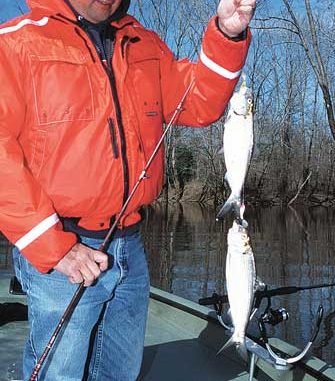
The American and hickory shad runs each spring provide non-stop Tar River action.
The Tar River originates in North Carolina’s piedmont near Roxboro and flows southeast for 140 miles.
In its upper reaches, the river’s bed is strewn with boulders, the depths are shallow and the current is swift. Each spring, however, the stream becomes burdened with clay and silt runoff from farms, turning its waters the color of bricks. But as the Tar enters the coastal plain, it become more docile and deeper, flowing another 37 miles before it becomes the Pamlico River.
The Tar-Pamlico system’s drainage is the state’s fourth largest, eventually emptying into Pamlico Sound. The link to the sound is important to anglers, because it provides a pathway for anadromous fish to travel inland in spring to complete spawning runs.
Tarboro is the epicenter of the river’s shad run. The town from which the river takes its name (or vice versa) became one with the stream in 1999 when Hurricane Floyd pushed the river out of its banks. The devastated town slowly recovered after the flood waters receded.
More recently, a drought has strangled the river’s flow. In spite of its ups and downs, there have always been fish to catch for anglers who understand its mysteries.
One such angler is Jimmy Dupree Jr., owner of Roberson and Dupree Shoe Store in Tarboro. A lifelong Tarboro resident, he knows the river as well as the aisles inside his shoe store.
“It’s unusual to see a lot of boats on the Tar River unless there’s a bass tournament,” Dupree said. “There may be some busy times on the weekends, but most weekdays, you’ll have the boat ramps to yourself.”
Dupree fishes for shad each spring. The two species that swim in the river are hickory and white shad (also called American shad). Hickory shad are generally smaller, topping out at around two to three pounds. White shad can grow much larger, reaching eight or 10 pounds.
But where the sizes overlap in their lower weight ranges, the way to tell them apart is by looking at their lips. The lower jaw of a hickory shad extends beyond its upper jaw. The difference is pronounced and distinct when compared to the equal extensions of a white shad’s jaws.
“Early in the season, beginning sometime in February, the shad run starts, and the action picks up.” Dupree said. “The white shad arrive later, with the best runs in April and May. But you might catch either species at any time you’re on the river. One day, you’ll catch mostly hickory shad; the next time you may catch mostly white shad.”
Dupree launched from the Bell’s Bridge ramp at NC 33 (north of Tarboro) with Anthony Ng, the owner of Fish-Ng Accessories, a manufacturer of several fishing products.
“Shad fishing is a nice break from grouper fishing,” Ng said. “I like to catch little fish too, and you can’t always go offshore. The wind may be blowing too hard, or you may not have the time to spend an entire day away from home. It’s so easy to go shad fishing, because it doesn’t take much preparation. All you do is throw a spinning rod in the boat and go.”
Ng lives in Winterville, a short drive from Tarboro. He and Dupree often get together to catch shad and other fish. Dupree often takes his son, Daniel, whenever he can take a break from his studies at East Carolina University.
“I like fishing for shad because they’re so much fun to catch on light tackle,” Daniel Dupree said. “The joy of shad fishing is that it’s the first fish you get to catch after a long winter layoff. You’re really excited to be fishing again, but you still have to be patient. You have to wait for schools to come through.
“For a long time, you may catch nothing. Then all of a sudden, you’re getting multiple hookups. Sometimes you can’t keep a lure in the water. You’re catching shad so fast, all you can do is reel them in until you’ve landed one or two fish on every rod.”
Daniel Dupree said he caught six fish on a recent trip, but he lost several shad that jumped after being hooked.
“When they jump, they sometimes throw the hook,” he said. “We don’t keep them anyway. We just shake them loose from the hook while the fish is in the water. They have soft mouths. On a good day, we catch a few dozen.”
“Sometimes, we keep a few fish,” Jimmy Dupree said, “but only when the stripers are running. There’s a good run of stripers in April and May, and fresh cut shad make great baits. We cut them into chunks and fish them on the bottom.”
When he wants to put shad in the boat, Dupree uses a landing net, which is a more reliable way of landing a shad than lifting it by the line.
“I use light tackle to catch shad: a Shimano 2000 Spirex reel and a 6-foot Shimano graphite spinning rod,” Dupree said. “I like a graphite rod because it’s so sensitive. I use a long-butt style, so it fits into a rod holder. The line is 10-pound, clear-blue mono. I make leaders out of the same line.”
Shad are often referred to as “poor man’s tarpon” or “miniature tarpon.” Like tarpon, shad have shiny silver sides and are capable of multiple leaps of great height compared to their body size.
“I don’t cast out and reel the line back in,” Dupree said. “I think retrieving is the biggest mistake most fishermen make. Shad don’t like chasing lures, so I just cast the lines out and put the rods in rod-holders. I fish where there’s a good current: usually in the mouth of a creek or where the creek current meets the current out in the river channel. The current makes the spoon vibrate and the curlytail swim. For a shad, that’s all it takes. A school comes along, and the rods go off.”
“A lot of times, the first thing that tells you a fish is on is when you see the fish jump high as your head,” Dupree said. “Then you look at all of the rods to see which one the fish is on. I fish four rods at a time, and you’re looking from one to the other to see which one is bouncing or bending toward the fish.”
Dupree fishes three or four times each week during the spring run. He may try fishing at the mouths of several different creeks before he finds fish, but he often tries a different creek or part of the river channel than he fished during a previous trip, just for variety.
He may also launch from any of three ramps located at the Tar River near Tarboro. Besides the Bell’s Bridge ramp, two other ramps are south of the town. One is the Old Sparta landing at NC 42 and the other is the Falkland Landing at NC 222.
Dupree said some anglers find places to fish from the bank.
“There’s a ramp at Rocky Mount’s Battle Park,” he said. “It’s off Highway 64, and it’s owned by the city of Rocky Mount. Lots of fishermen fish from the bank at the park.”
When he travels the river, Dupree doesn’t waste any time, because he knows it so well. He owns a 17-foot G3 aluminum john boat powered by a 50-HP, 4-stroke outboard.
“They cleared most of the trees out of the river after Hurricane Floyd,” he said, “but there are still a lot of snags in the river. When the river’s down, you might also hit a sand bar if you’re not careful.”
When he’s looking for shad, Dupree usually heads for a “hole” (deeper spot) that he’s discovered and fished in the past with success. He likes to fish swift-flowing water that has a color change.
“The water coming out of the creeks is usually much darker and clearer than the river water, which can be pretty muddy during the shad run,” he said. “The fish will be at the edge of the color change.
“You might have to go up in one of the creeks to find the color change. It can be right in the mouth of the creek or out in the river channel.”
While the Duprees returns most of his shad to the Tar, Ng likes to take home some of the tasty fish.
“Sure, they make good striper bait,” Ng said. “I always take some home and freeze them for striper bait, but they are also good eating.
“I cut them into steaks, through the backbone like I do with a king mackerel. I cut the steaks about an eighth-inch thick and roll them in a mixture of half-seafood breader mix and half-flour. Then I fry the steaks in hot peanut oil and eat them, bones and all.
“But the roe is the best eating. I bread and fry the roe right along with the steaks. I make some cornbread and cole slaw to go with it, and that’s all I need.”

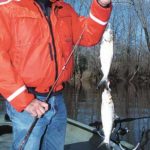
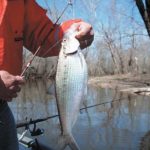
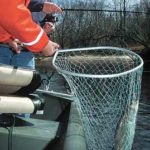
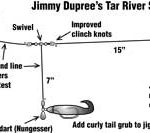
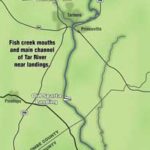



Be the first to comment